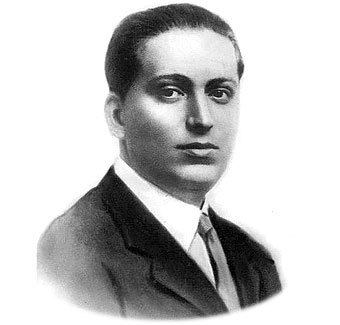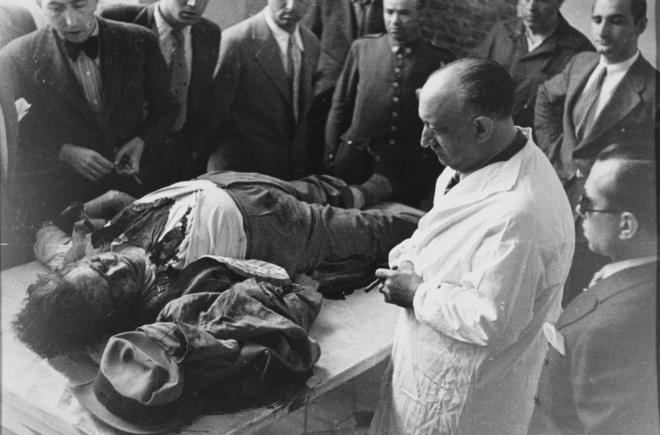Constituency La Coruna Preceded by Jose Corral Larre Name Jose Sotelo Siblings Joaquin Calvo Sotelo | Constituency Orense Role Spanish Politician Ex-spouse Enriqueta Grondona Constituency Orense Party Renovacion Espanola | |
 | ||
Succeeded by Francisco Moreno Zuleta Parents Elisa Sotelo Lafuente, Pedro Calvo y Camina | ||
Resting place Cementerio de la Almudena | ||
13 de julio de 1936 jose calvo sotelo es asesinado
José Calvo Sotelo (6 May 1893 – 13 July 1936) was a Spanish politician, minister of Finance during the Dictatorship of Miguel Primo de Rivera and a leading figure of the anti-republican radical right during the Second Republic. His assassination in July 1936 by a unit of the Guardia de Asalto was an immediate prelude to the triggering of the military coup plotted since February 1936 whose partial failure marked the beginning of the Spanish Civil War.
Contents
- 13 de julio de 1936 jose calvo sotelo es asesinado
- Hablamos hoy de jose calvo sotelo
- First years
- Dictatorship of Primo de Rivera
- Second Republic
- Assassination
- References

Hablamos hoy de jose calvo sotelo
First years
Calvo Sotelo was born on 6 May 1893 in Tui, Pontevedra, to Pedro Calvo y Camina and Elisa Sotelo Lafuente.

Calvo Sotelo, having just received his degree in Law, moved to the capital, Madrid and joined in 1913 a maurist circle in the Ateneo where he hanged with other members of the Maurist Youth such as Melchor Fernández Almagro, Pío Zabala, Antonio Ballesteros Beretta, Pío Ballesteros Álava, Quintiliano Saldaña, Manuel Palacios Olmedo, Rogerio Sánchez and Fernando Suárez de Tangil. He became Secretary of the Academy of Moral and Political Sciences of the Ateneo Mercantil de Madrid and university professor of the Universidad Central. He was a member of Antonio Maura's Conservative Party. He first served as an administrative officer in the Ministry of Grace and Justice.

In the 1919 election to the Congress of Deputies, despite Maura having in mind the plan of not presenting a Maurista in the district of Carballino in exchange for a seat in another district, a 25 years old Calvo Sotelo ended up imposing his will of presenting himself as candidate. Challenging mainstream conservative candidate Leopoldo García Durán, follower of Gabino Bugallal (Count of Bugallal), Calvo Sotelo finally obtained the seat in the election.

In 1922 he was made civil governor of Valencia.
Dictatorship of Primo de Rivera
After the 1923 coup d'état by Miguel Primo de Rivera, Calvo Sotelo lent support to the dictatorship of the later. Appointed Director General of Local Administration in 1923, he was the maker of the 1924 Municipal Statute, that, inspired by previous projects of Antonio Maura, sought to reform the structure of the State at a local level and was cemented by the free election of the Mayor and the Ayuntamiento. He also elaborated a Provincial Statute in 1925. Both legislations never got to be actually enforced. Primo de Rivera appointed Calvo Sotelo as finance minister of the Civil Directory of the dictatorship in 1925, and he served from December 1925 until January 1930. During his tenure as Minister of Finance, his program in order to achieve economic growth featured protectionist, nationalist and interventionist policies.
Second Republic
After the proclamation of the Second Spanish Republic on 14 April 1931, Calvo Sotelo, because of his prior collaboration with the dictatorship and the subsequent fear to being subject to a trial, exiled to Portugal and later to France along other politicians. He was welcomed the next day after his arrival to Lisbon by Salazar, then minister of Finance. Calvo Sotelo spent his time in Portugal studying the Ditadura Nacional regime. After being facilitated a passport by the Portuguese authorities, he lived between February 1932 and May 1934 in Paris, where he became connected with the ideas of Charles Maurras. Aside from Maurras, he also befriended Léon Daudet, Jacques Bainville and Charles Benoist in France. Despite his exile he had been elected as member of the parliament for the district of Orense both in the 1931 and 1933 elections. After the passing of an Amnesty Law in 20 April 1934, he returned to Spain with the intention of leaving a more totalitarian imprint in the Alfonsine radical right, then represented by Renovación Española and led by Antonio Goicoechea. On 9 May he was already in the Cortes. He defended that the "Restoration" of the prior liberal monarchy was not intended, but the "instauration" of an anti-liberal one. The figure of Calvo Sotelo, who had more personal charisma than Goicoechea, eventually eclipsed the later. He became the leading figure of the Bloque Nacional ('National Block'), a newly created electoral project that sought to unite the Anti-republican right. The foundational manifesto espoused a return to traditional values, through the means of an authoritarian monarchy and the role of the Armed Forces as counter-revolutionary agent. Neither the leader of the CEDA (José María Gil-Robles) nor the leader of the Falange Española de las JONS (José Antonio Primo de Rivera) endorsed the initiative, which, aside from members of Renovación Española, drew most of its support from the ranks of the traditionalist carlists; it was also supported by the small group headed by the Doctor Albiñana, leader of the Spanish Nationalist Party.
After the victory of the leftist Popular Front in the February 1936 election, José Calvo Sotelo became the leading speaker of the anti-republican right in the Parliament, preparing the mood of the right wing masses for a coup d'état.
Assassination
After Guardia de Asalto leader José Castillo was killed by falangists at 10pm on 12 July, in the first hours of 13 July a group of Guardia de Asalto and other leftist militiamen led by Civil Guard Fernando Condés went to Calvo Sotelo's house in a revenge mission, arrested him and later killed him with gunshots in a police truck. His body was later dropped at the entrance of one of the city's cemeteries. According to all later investigations, the perpetrator of the murder was a socialist gunman, Luis Cuenca, who was known as the bodyguard of PSOE leader Indalecio Prieto.
In the days following, the Spanish government undertook a routine investigation that never reached any conclusion. The cabal of anti-republican conspirators led by General Emilio Mola seized the ideal moment, accelerating the triggering of the military coup that was being plotted underway already since the February election. The uprising of part of the Army, starting with the Army of Africa in Melilla on 17 July 1936, under the assumed command of Generals Emilio Mola, Francisco Franco, Gonzalo Queipo de Llano and José Sanjurjo, marked the beginning of the Spanish Civil War.
